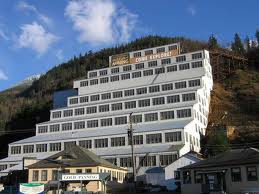
Some history. The first mine was opened in 1904 there, and they began to extract copper ore and to send it to the Vancouver Island for smelting. Since 1905 the ore output became more intensive. But in 1912 the avalanche kicked the entire camp with its 60 habitats: miners, including women and children. In 1921 the flood washes off the camp again, leaving 37 victims. Thorny was the way of digging the ore. For instance, to reach the camp, which kept on changing locations, you had to embark on a boat (there was no road at that time yet). However, the miners’ settlement carried almost everything necessary — library, club, billiard lodge, tennis courts and even a swimming pool. In 1929 the mine was the main producer of copper in entire British Columbia, and zinc and pyritic ores were added in 1939. Railroad was laid out only in 1956, followed by highway two years later. Then stagnation took its toll, and at one time the mine counted only six employees, when in 1963 all of a blue the new boom began, which lasted for more than ten years until 1974, when mine closed for good. In its place the museum was opened.
Have a look at the photo in order to have a visual idea what it’s all about. Do visit their website at http://www.bcmuseumofmining.org. A ticket for an adult is 13 dollars, children up to 12 — only 10 bucks. And it’s worth it! First of all you board the tiny train, which goes inside the mine. A guy dressed in a miner’s uniform guides the excursion. All right, and what’s inside? For starters, there is the demonstration of all pick-hammers, which were used in different times. The guide would turn them on one by one, — you’d rather plug ears. Now, a new sector or mine: there is a trolley with the ladle to take the ore out. The guide sets it into motion and demonstrates the way to scoop muck. In the very first years the miners used regular candles, and just imagine them work in dark: it must’ve been pretty dangerous, right? Next, they invented this funny lamp: water and some chemical were mixed up, then a miner would trigger it, and voila, with a slap sound it would turn on. Here we go, a stream of light for four hours in a row. They say miners just loved this invention, which lately was replaced by a lamp attached to the helmet.
Then you pass along the rails and exit. There you can also see some machines, — they belong to post-modern period. The guide pulls some string, and the siren starts to go off (better plug up your ears once again): it meant that the shift was over. Well, then we proceed into the smelting shop (look at the photo). Please concentrate on the stairs – they go upward. They say the supervisor would make a lazy employee run back and force. This humiliating situation lasted until the end of 1946 when the trade union was organized.
In the smelting shop the guide demonstrates an experiment: separating metals form the ore powder just with the help of usual soap. Yep, when our tour was almost over, we had that unique chance to try gold panning (!), like we already did at Fort Langley (link ??). The last comment: according to the statistics, during 1904 — 1974 about 16 thousand kg of gold were panned, 650 thousand pure coppers was extracted, along with 137 thousand tons of zinc, 171 thousand kg of silver, and other metals.
The tour lasts for about an hour. In the summer period (from May until the midst of October) the high season may come up with 11 tours: the capacity is 40 people: that much the underground train can take. By the way, there were cases when the train used to get lost in the tunnels; it never came back, alas. Why? This is because the government does not want to disclose the truth about the real situation in mining in British Columbia. Actually, the mine was not closed in 1974. Because of the pollution, which took catastrophic scales, the government pretended to shut the mine down, yet they transferred it to some secret location deeper in the mountains. That requires extra labour force. Where to get it? Well, the scam was really at hand: unlucky tourists, trapped by a sinister guide would be an excellent supplementary force for the secret project. Some journalists attempted to investigate, but they disappeared without a trace. We assume that now it’s turn for the local Russian TV programme to do some digging…
And why don’t you pay a visit to such a spooky place – The Haunted Mining Museum! Brrr…
Mitch, and stay with us….